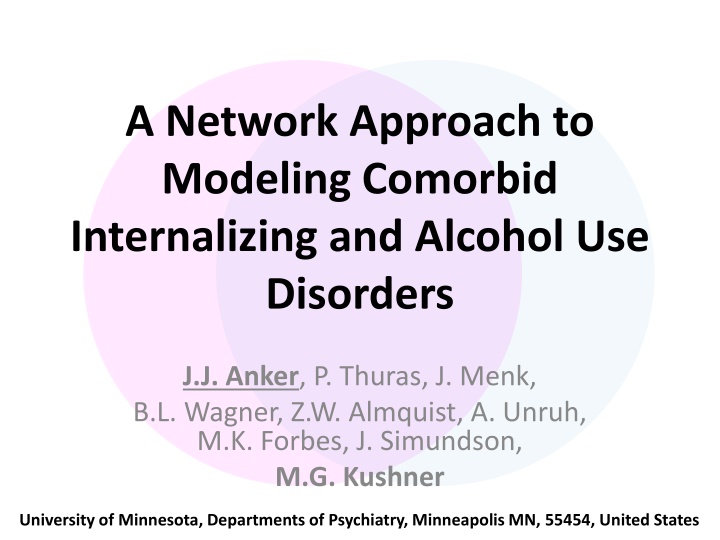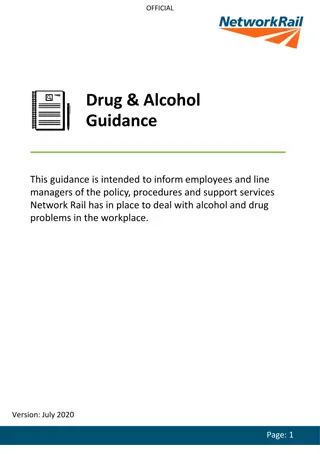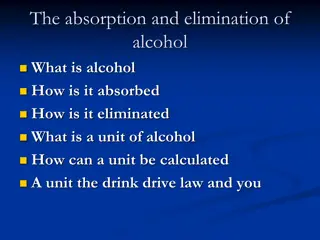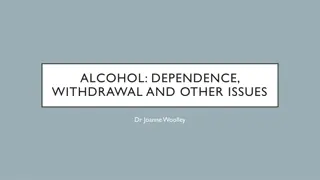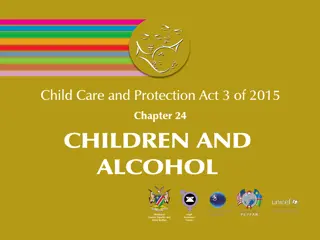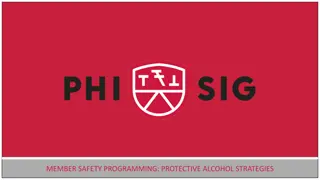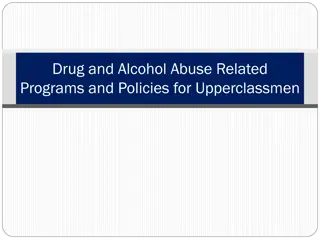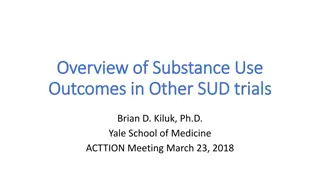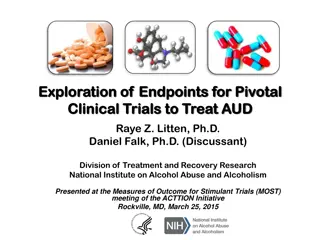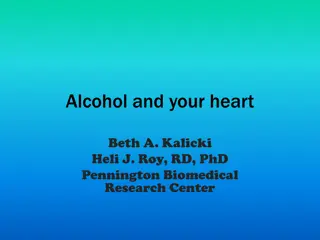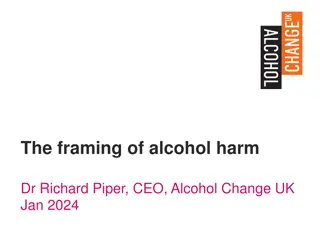A Network Approach to Comorbid Internalizing and Alcohol Use Disorders
Highly prevalent comorbidity among AUD patients with anxiety and depression disorders presents challenges in treatment effectiveness and relapse risk. This study aims to visualize the network structure of comorbid INT and AUD to identify key treatment targets.
Download Presentation

Please find below an Image/Link to download the presentation.
The content on the website is provided AS IS for your information and personal use only. It may not be sold, licensed, or shared on other websites without obtaining consent from the author.If you encounter any issues during the download, it is possible that the publisher has removed the file from their server.
You are allowed to download the files provided on this website for personal or commercial use, subject to the condition that they are used lawfully. All files are the property of their respective owners.
The content on the website is provided AS IS for your information and personal use only. It may not be sold, licensed, or shared on other websites without obtaining consent from the author.
E N D
Presentation Transcript
A Network Approach to Modeling Comorbid Internalizing and Alcohol Use Disorders J.J. Anker, P. Thuras, J. Menk, B.L. Wagner, Z.W. Almquist, A. Unruh, M.K. Forbes, J. Simundson, M.G. Kushner University of Minnesota, Departments of Psychiatry, Minneapolis MN, 55454, United States
Conflicts of Interest Statement I, or an immediate family member, including a spouse or partner, have no financial relationships or any other relationship which could reasonably be considered a conflict of interest relevant to the content of this CE activity.
Objective 1: Visualize the network structure of the Vicious Cycle Model of comorbid internalizing (INT) and alcohol use disorder (AUD). Objective 2: Probe the contribution of specific elements to network connectivity to identify high value treatment targets.
Problem and Background
Comorbidity is highly prevalent among AUD patients Among AUD patients, rates of anxiety and depression disorders range between 25% to 50% AUD INT (Kushner, Krueger, Frye, & Peterson, 2008; Kushner et al., 2012)
Comorbidity interferes with AUD treatment Among AUD patients, rates of anxiety and depression disorders range between 25% to 50% AUD INT Dependence severity Withdrawal severity Persistence of AUD x2 Relapse Risk (Cornelius et al., 1997; Greenfield et al., 1998; Haver, 2003; Helzer & Pryzbeck, 1988; Kushner et al., 2005; Regier et al., 1990; T masson & Vaglum, 1995)
Treatment of INT does not improve AUD outcomes among comorbid individuals(meta-analysis by Hobbs et al., 2011) COMORBIDITY AUD INT x2 Relapse Risk
This suggests conditions beyond INT maintain comorbidity and increase risk for AUD relapse COMORBIDITY AUD INT x2 Relapse Risk
DTC increases risk for AUD by a factor of 5 among those with an anxiety disorder 6 6 5.574 ORs for Developing AUD between 5 5 4 4 Waves 1 and 2 3 3 2 2 1 1 1.047 0 Drinking to Cope NO Drinking to Cope ASM ANSM Menary, Kushner, Maurer, Thuras (2011). The prevalence and clinical implications of self-medication among individuals with anxiety disorders, JAD, 25, 335-339
Models of Comorbidity
Comorbidity develops through negatively reinforced drinking i.e., self-medication of INT symptoms AUD DTC Self-Medication (AUD INT) AUD INT
Drinking leads to stress-related neurobio adaptations and negative psychosocial consequences INT DTC Self-Medication (AUD INT) AUD INT Consequences of Drinking (AUD INT) AUD INT Stress
Combined, these processes form the Vicious Cycle Model of comorbidity DTC AUD INT Stress Stress
The Vicious Cycle provides an explanation of why treatment of INT does not improve AUD outcomes DTC AUD INT Stress
INT treatment alone fails to address DTC, which remains available to maintain or re-initiate the Vicious Cycle DTC AUD INT Stress
Study Objectives Objective 1: Use network analysis to visualize the structure of unique relationships between elements of the vicious cycle model. DTC AUD INT Comorbidity Stress Objective 2: Characterize changes in network structure when controlling for specific elements. Identify central elements, that, if removed, would maximally disrupt relationships among other elements in the network.
General Methods
Sample 363 AUD Residential inpatients with a comorbid anxiety disorder Assessed at the beginning of residential AUD treatment AUD INT
Sample 363 AUD Residential inpatients with a comorbid anxiety disorder Assessed at the beginning of residential AUD treatment Level of Analysis Most NA studies in psychopathology define network elements at the symptom level A smaller number define elements at the symptom/behavioral aggregate level We adopt the former to align with the theoretical conceptualization of the vicious cycle AUD INT
Sample 363 AUD Residential inpatients with a comorbid anxiety disorder Assessed at the beginning of residential AUD treatment Level of Analysis Most NA studies in psychopathology define network elements at the symptom level A smaller number define elements at the symptom/behavioral aggregate level We adopt the former to align with the theoretical conceptualization of the vicious cycle Measures Network elements operationalized as summary scores representing levels of the following constructs: Depr DTC Gen Anx Crave Self E AUD INT Social Drink Agor Stress Panic
Objective 1: Visualizing the Network Structure of the Vicious Cycle
Using GLASSO to visualize the structure of unique relationships within the Vicious Cycle GLASSO Network *Lines/edges represents the relationship between two elements while controlling for all other elements
DTC and stress served as bridging elements between internalizing and alcohol elements GLASSO Network Element Legend Alcohol DRI CRA Craving DRI Total Drinks Internalizing - Distress GA Gen Anxiety CRA DEP Depression Internalizing - Distress GA SOC Social Anxiety DTC SEL PAN Panic AGR Agoraphobia SOC STR PAN Vicious Cycle DTC Drinking to Cope DEP SEL Self-efficacy AGR STR Perceived Stress *Lines/edges represents the relationship between two elements while controlling for all other elements
DTC was the most central element in the GLASSO network GLASSO Network Centrality Plot results forDTC Betweenness Closeness Strength DRI CRA DTC GA DTC SEL SOC STR PAN Betweenness: lies on the shortest path between other elements Strength: has the highest sum of connected edge weights Closeness: has the highest # of actual (vs. possible) connections DEP AGR *Lines/edges represents the relationship between two elements while controlling for all other elements
Objective 2: Models Probing the Contribution of Specific Elements to Network Connectivity
Azero-order correlation matrix was plotted using the Fruchterman and Reingold algorithm Baseline/Association Network Element Legend Alcohol We computed a series of semi-partial correlations that systematically controlled the variance associated with selected individual elements in the model. Vicious Cycle CRA Craving SOC DRI Total Drinks Internalizing - Distress STR GA Gen Anxiety GA DEP DEP Depression Internalizing - Distress CRA AGR PAN SOC Social Anxiety DTC PAN Panic AGR Agoraphobia SEL DTC Drinking to Cope SEL Self-efficacy DRI STR Perceived Stress
After controlling for DTC the alcohol elements became isolated. Baseline/Association Network DTC Probe SOC DRI CRA STR GA DEP CRA AGR PAN DTC GA AGR SEL SEL STR DEP SOC DRI PAN
Baseline/Association Network DTC Probe SOC DRI CRA STR GA DEP CRA AGR PAN DTC GA AGR SEL SEL STR DEP SOC DRI PAN
This level of change was unique to the influence of DTC Stress Probe Distress Probe DRI AGR CRA CRA DTC Probe PAN SEL DRI DTC DTC SOC PAN DRI CRA SEL SOC DEP AGR GA STR Fear Probe Internalizing Probe GA STR SEL GA AGR STR SEL CRA SEL STR DEP DTC DTC DEP SOC PAN CRA DRI DRI
This study characterized relationships between elements of the Vicious Cycle Model using network analysis. Summary of findings: 1. DTC served as a bridge between internalizing and alcohol elements. 2. Centrality indices indicated that DTC ranked as the most central element in maintaining network coherence. 3. After controlling for DTC, alcohol elements became isolated from the other network elements. This level of change was unique to the influence of DTC and did not occur after other elements were controlled. Conclusion: These findings inform clinical hypotheses for interventions targeting DTC to eliminate the connection between comorbid internalizing and alcohol use disorders.
Acknowledgements Federal Grant Support NIAAA: R01 AA015069 Awarded to Matt. G. Kushner Mentor Support Matt G. Kushner John Grabowski Marilyn E. Carroll NIDA: T320A037183 To support the work of the Justin J. Anker and Miri K. Forbes Data collection Joani Van Demark Eric W. Maurer Chris Donahue Brenda Frye Kyle R. Menary Jennifer Hobbs Angela M. Haeny
Study Sample the average age was 39.3 (standard deviation [SD] = 10.24) 38% were female (N = 138). Patients with more than one of the three anxiety disorders required for inclusion in the study were asked to identify their primary disorder in terms of its interference in their daily functioning: 41.7% endorsed primary social anxiety disorder (N = 151) 40.3% endorsed primary generalized anxiety disorder (N = 146) 14.9% endorsed primary panic disorder without agoraphobia (N = 54) 3.0% endorsing primary panic disorder with agoraphobia (N = 11) two or more co-occurring anxiety disorders (56.0%, N = 201) met diagnostic criteria for major depression (51.4%, N = 186).
Study Assessments Internalizing Distress Measures (Blue) Generalized Anxiety 64.13 (11.59) Penn State Worry Questionnaire (GA) Depression (DEP) 20.40 (9.09) Beck Depression Inventory Internalizing Fear Measures (Red) Social Phobia (SOC) 32.43 (17.30) Social Phobia Scale Panic Disorder (PAN) 10.99 (6.34) Panic Disorder Severity Scale Mobility Inventory for Agoraphobia (AGR) 31.59 (19.78) Agoraphobia Alcohol-Related Measures (Pink) Obsessive Compulsive Alcohol Craving (CRA) 2.67 (1.05) Drinking Scale Total Drinks 4 Months 1608.76 (1271.51) Time Line Follow-Back Interview Before Treatment (DRI) Stress and Coping Measures (Yellow) Perceived Stress (STR) 28.15 (5.50) Perceived Stress Scale Drinking to Cope with Inventory of Drinking Situations 62.93 (12.15) Negative Affect (DTC) Unpleasant Emotions Subscale Situational Confidence Coping Self-Efficacy 32.91 (10.91) Questionnaire (SEL) Negative Emotions Subscale
